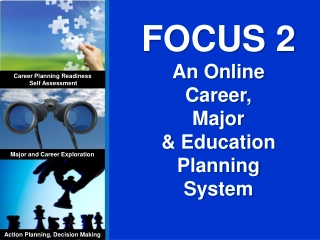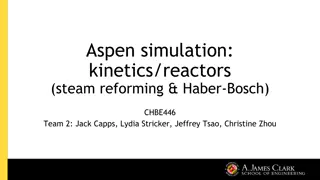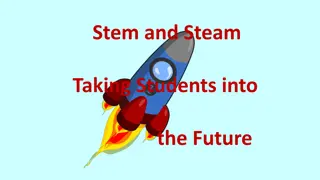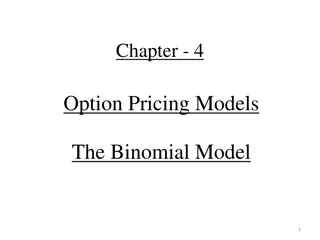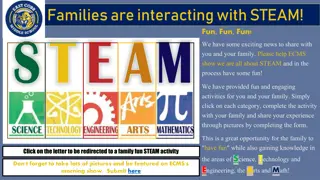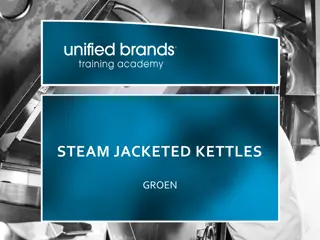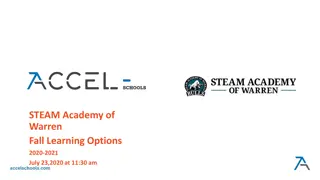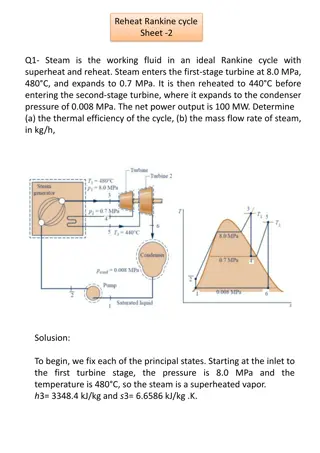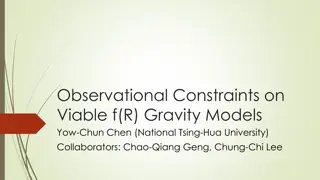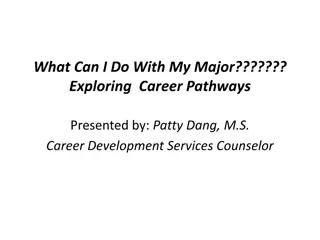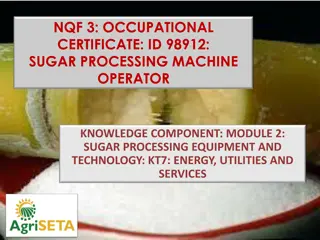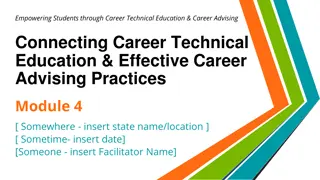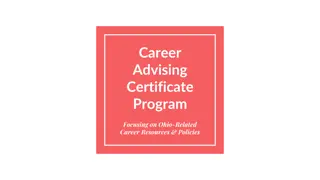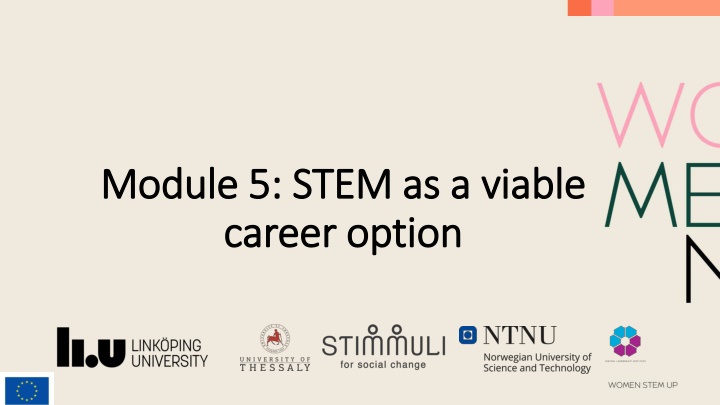
Empowering Women in STEM Careers: Challenges and Opportunities
Explore the gender disparity in STEM fields, discover the skills needed, and find out why tailored support tools are crucial. Learn how to inspire and support students in all STEM career paths. Uncover the significance of role models and the concept of ESTEAM for a creative approach to education.
Download Presentation

Please find below an Image/Link to download the presentation.
The content on the website is provided AS IS for your information and personal use only. It may not be sold, licensed, or shared on other websites without obtaining consent from the author. If you encounter any issues during the download, it is possible that the publisher has removed the file from their server.
You are allowed to download the files provided on this website for personal or commercial use, subject to the condition that they are used lawfully. All files are the property of their respective owners.
The content on the website is provided AS IS for your information and personal use only. It may not be sold, licensed, or shared on other websites without obtaining consent from the author.
E N D
Presentation Transcript
Module 5: STEM as a viable Module 5: STEM as a viable career option career option
Introduction Introduction This module provides background information, statistics and literature review that is essential for trainees to understand the gender disparity in STEM fields and the reasons why tailor-made tools to support women in these fields are necessary. Through this module, trainees will obtain techniques and tools that, as educators, can use to support students in exploring all STEM career options beyond the widely known ones. In addition, they will be introduced to role models to inspire students and educators on the possibilities that STEM offers. Finally, they will be introduced to the concept of ESTEAM and the career options it entails. ESTEAM is a multidisciplinary approach and presenting it here aims at inspiring educators to approach their own fields and their students career perspectives in a more creative manner.
Outcome of the module Outcome of the module Trainees will find techniques and tools to use in supporting their students in their career exploration. Inspirational material in ESTEAM and the significance of role models are also provided here to be used as sources of inspiration for both educators and students. Educators will get an understanding on the how entrepreneurship is related to STEM and the Arts.
STEM careers challenges and opportunities STEM careers challenges and opportunities According to data from Eurostat, the European Union s statistics agency, there were more than 6.3 million female scientists and engineers in the EU in 2019, accounting for 41% of total employment in science and engineering1. However, only 34% of graduates in STEM (science, technology, engineering and mathematics) fields in the EU were women in 2022. This proportion varied widely across the EU Member States, ranging from 55% in Lithuania to 28% in Luxemburg1. The most common degree awarded to women in STEM in the EU was for management and administration3. Some of the factors that may discourage women from pursuing careers in STEM include lack of confidence, stereotypes and lack of role models4. 1 https://ec.europa.eu/eurostat/web/products-eurostat-news/-/edn-20210210-1 3 https://ec.europa.eu/eurostat/statistics-explained/index.php?title=Tertiary_education_statistics 4 https://knowhow.distrelec.com/stem/women-in-stem-in-eu/
Skills STEM professionals acquire in the Skills STEM professionals acquire in the educational educational programmes programmes Engineering students expect that the skills taught in engineering courses will be the skills they will use in the field. Engineering degree programs largely ignore a variety of areas of expertise and skills that are required to be successful. Engineers need to be also good communicators, they need to be good managers, they need to be organized, and they need to understand the complexities of the relationship between the technical things they re working on and other social processes. A narrow math and science emphasis disproportionately disadvantage women because it emphasizes male stereotyped skills while devaluing skills that are gender neutral or female-stereotyped, such as writing, communication, and managerial skills.
The significance of role models The significance of role models Many girls lack access to role models who can inspire them to imagine all that they can achieve from academic success to amazing careers. Role models have a powerful and positive impact on girls, including their attitudes toward various careers, such as in STEM fields. Videos make it easy to bring these role models right to the girls you work with, engaging and empowering them to set and achieve academic and career goals and to believe in their ability to succeed.
Example 1 Example 1 Software Engineer Engineer Software Link to the video: https://www.careergirls.org/role- models/software-engineer-1/
Example 2 Artificial Example 2 Artificial Intelligence Engineer Intelligence Engineer link to the video : https://www.careergirls.org/role- models/artificial-intelligence-engineer- amy-hemmeter/
Example 2 Maps and data Example 2 Maps and data operations manager operations manager link to the video : https://www.careergirls.org/role- models/data-operations-manager- kimberly-xie/
How to reduce gender disparity? Introduction How to reduce gender disparity? Introduction to the concept of ESTEAM to the concept of ESTEAM The term ESTEAM incorporates the fields of STEM with the field of Entrepreneurship and Arts to show the cross-disciplinary nature of these fields. The term STEAM is more commonly met in both non-academic and academic analysis and it refers to a teaching framework. Professor Georgette Yakman and her team put forward STEAM education (science, technology, engineering, art and mathematics) on the basis of STEM education, constructed the STEAM education framework, designed the STEAM teaching process card, and STEAM education training certification. STEAM education based on mathematics, engineering and art from the perspective of science and technology, interdisciplinary concept of different subjects will be integrated for the development of modern society to provide excellent human resources support.
How to reduce gender disparity? Introduction How to reduce gender disparity? Introduction to the concept of ESTEAM to the concept of ESTEAM The goal of the STEAM framework is to improve the students innovative ability. For STEM, the purpose is to focus on real-world learning through hands-on investigations and projects. Whereas in STEAM, it s more about the process. We re asking students to discover a problem through inquiry and then design a solution through creativity. This process leads to an end product which can then be refined based on feedback. Finally, in arts integration, we re focused on building connections across a variety of content areas to deepen learning and provide an opportunity for students to apply what they ve learned in each content area in a new way.
A table to assist A table to assist educators in educators in understanding understanding STEM vs STEAM STEM vs STEAM The Institute for Arts Integration and STEAM provides more information here: https://artsintegration.com/2022/07/13/stem- vs-steam/
STEM vs STEAM STEM vs STEAM E-STEAM learning combines the principles of entrepreneurship with STEM disciplines and the Arts and fosters entrepreneurial competencies among students. Entrepreneurial context and STEM context share some common goals because both aim to develop students problem-solving, critical thinking, and creativity. These competencies are not limited to STEM practitioners, but they are fundamental for entrepreneurs. https://www.highereducationdigest.com/igniting-innovation-the- power-of-entrepreneurial-stem-learning-in-higher- education/#:~:text=In%20today's%20rapidly%20evolving%20world,STE M)%20learning%20into%20their%20curricula
Why is entrepreneurship in the context of Why is entrepreneurship in the context of STE(A)M important? STE(A)M important? By incorporating entrepreneurial practices into existing STEM curricula, new learning platforms will be created that encourage networkability, financial awareness and functionality. Students will develop important skills such the ability to identify and analyze challenges as well the ability to adapt to evolving situations. These are necessary skills for individuals to enter the workforce. There are numerous professional roles that can fit into the concept of ESTEAM and require a degree in STEM in combination with entrepreneurial and artistic skills or studies. The examples below illustrate what ESTEAM means in the real professional world. Video Game Developer: Game development is a multidisciplinary field that combines technology, mathematics (especially in coding and physics engines), and creativity in storytelling, character design, and visual art. Game developers often need entrepreneurial skills to market and distribute their games. Biomedical Illustrator: This role combines biology, technology, and art. Biomedical illustrators create visual representations of complex medical and scientific concepts, such as anatomical illustrations and medical diagrams. They use their artistic talents to make these concepts more accessible to a wide audience. Fashion Technologist: In the fashion industry, technologists merge technology and creativity. They work on innovations like smart textiles, wearable technology, and sustainable fashion practices, blending engineering and design principles with entrepreneurial skills to market and sell their creations.
Develop Develop Develop mentoring, to provide one-on-one career advice and role models to show the path, as well as the destination. Develop and sustain interest in STEM education and careers. Combating stereotypes threat e.g, women aren t good at math Community building, combining all the above ideas, adding institutional commitment and support for building capacity. Measure the achievements of specific goals.
Cultivate a sense of belonging (1/2) Cultivate a sense of belonging (1/2) Female students often report that they don t feel as if they belong in engineering and computing fields. By emphasizing the wide variety of expertise necessary to be a successful engineer or computing professional including less stereotypically masculine skills such as writing, communicating, engineering and computing programs can help young women see engineering and computing as fields in which they belong.
Cultivate a sense of belonging (2/2) Cultivate a sense of belonging (2/2) Universities in general and departments and board of educations in particular could: Develop career-based scenarios and description of the utility of the educational programs to enhance students interest in science and their understanding of STEM careers by presenting them with authentic and engaging problems that are related to real-world STEM professions. Develop networks and stimulate teachers, industry representatives and administrative staff to become mentors for the students. Inform the students about professional associations and stimulate students to become members so that they can start building and belonging to networks. Arrange study days with focus on equality and gender and explain the value of becoming engineers for society, and for women. Engage teachers in the development of mentorship programs and encourage students to meet experts, distinguish researchers and managers to get an accurate picture of the areas, the academic value, and the importance of the STEM areas for research and innovation.
Who can be a mentor Who can be a mentor: A professor, an industry expert, a professional in a field of interest for the student. A mentor is a person with experience, knowledge and connections who can help advance the career of another, usually more junior person1 There are different types of mentors2: Peer mentors: professional colleagues who offer advice. Career mentors: tend to be in a higher position than their mentees and serve as career advocates and guides. Life mentors: usually at the senior stages of a career and may work within or outside of the mentee's current company. 1 https://www.thebalancemoney.com/a-guide-to-understanding-the-role-of-a-mentor-2275318 2 https://www.indeed.com/career-advice/career-development/what-is-a-mentor
Why is mentorship important for female Why is mentorship important for female students? students? It helps women learn and grow from the experience of other women who have faced similar challenges and opportunities in their careers. Provide women with valuable feedback, guidance, support, and encouragement to achieve their goals and overcome obstacles. It empowers women to become leaders and role models in their organizations and industries. Mentoring can help women develop leadership skills, gain self-confidence, and expand their network and influence. It addresses the gender gap and inequality that still exist in the workplace. It addresses the gender gap and inequality that still exist in the workplace. Women are less likely to find a mentor and move up without the help of other women1. Mentoring can help women overcome barriers and advocate for themselves and others. It creates a culture of diversity, inclusion, and collaboration in the workplace. Mentoring can foster a sense of belonging, trust, and respect among women and between women and men. Mentoring can also promote cross-cultural understanding and awareness, as well as innovation and creativity. Mentoring can help create a positive and productive work environment for everyone. 1 https://www.mentorcliq.com/blog/women-mentoring-women
Tips and tools for mentors Tips and tools for mentors 1) Choose mentees carefully: Although the prospect of having an energetic and personable junior partner for a multitude of projects is appealing, the wrong mentee can be painful. 2) Establish a mentorship team. The exclusive one-on-one relationship of mentor and mentee, long the norm, has been replaced by sharing responsibility with others for the growth of a mentee. 3) Run a tight ship. Establishing firm and clear ground rules with mentees can improve efficiency. 4) Head off rifts or resolve them. Mentor-mentee rifts are common in both business and academia, and they often aren t dealt with as quickly as they should be. 5) Don t commit mentorship malpractice. It s easy for mentors to wield their power inappropriately even if they re not fully aware of it. 6) Prepare for the transition. A mentor s accumulated wisdom and expertise must be passed on to the next generation
Questions to be discussed Questions to be discussed How to communicate the Importance of STEM knowledge today s society in everyday teaching and everyday students activities? How to describe and embed the value of STEM educational programmes? The importance of cultivating a sense of belonging? How can I support more girls/ women pursuing STEM studies and careers?
Tools & Questions to ask yourself and your Tools & Questions to ask yourself and your students (1/2) students (1/2) What does an aerospace engineer, for example, do? What skills are needed? What is the pay? What is the career outlook? Select the STEM cluster you prefer and investigate the career about which you want to teach your students. Ex. Aerospace engineer (link: https://www.careergirls.org/careers/aerospace-engineer/
Tools & Questions to ask yourself and your Tools & Questions to ask yourself and your students (2/2) students (2/2) Tools for a mentor: The GROW Model https://www.coachingcultureatwork.com/the-grow-model/ GROW provides a framework for a coaching session, a conversation, a meeting or a project and is the best-known coaching model in the world today. Other tools for career-consulting For an exercise use the Cool Career Facts to ask your student to remember the surprising and fun facts about the widely diverse careers. Help your students notice cool facts that might spark a student s interest. What makes a career stand out? (link - Page 29: https://www.careergirls.org/wp- content/uploads/2020/10/Teachers-Toolkit-Career-Girls-Guide-Oct- 2020.pdf
E E- -STEAM References: STEAM References: Article: Igniting Innovation: The Power of Entrepreneurial-STEM Learning in Higher Education,Dr. Marwa Eltanahy, Lecturer, Higher Colleges of Technology,May 25, 2023, https://www.highereducationdigest.com/igniting-innovation-the-power-of- entrepreneurial-stem-learning-in-higher- education/#:~:text=In%20today's%20rapidly%20evolving%20world,STEM)%20learning%2 0into%20their%20curricula STEM vs. STEAM vs. Arts Integration:A Comparison Guide for Educators https://artsintegration.com/2022/07/13/stem-vs-steam/ Other resources: A teacher s guide e-STEAM-ed Individuals: The significance of Art in STE(A)M,Kristen Feigel, Illinois Math and Science Academy https://digitalcommons.imsa.edu/rl_cpg_4/15/

